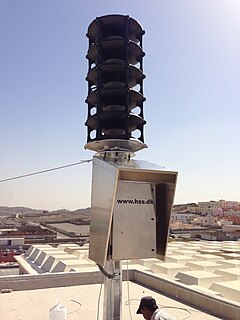 W
WWarning system is any system of biological or technical nature deployed by an individual or group to inform of a future danger. Its purpose is to enable the deployer of the warning system to prepare for the danger and act accordingly to mitigate or avoid it.
 W
WThe No.1 class auxiliary patrol boat was a class of patrol boat of the Imperial Japanese Navy (IJN), serving during World War II. 280 vessels were planned under the Maru Sen Programme, however, only 27 vessels were completed before the end of the war.
 W
WAn acoustic mirror is a passive device used to reflect and focus (concentrate) sound waves. Parabolic acoustic mirrors are widely used in parabolic microphones to pick up sound from great distances, employed in surveillance and reporting of outdoor sporting events. Pairs of large parabolic acoustic mirrors which function as "whisper galleries" are displayed in science museums to demonstrate sound focusing.
 W
WAn airborne collision avoidance system operates independently of ground-based equipment and air traffic control in warning pilots of the presence of other aircraft that may present a threat of collision. If the risk of collision is imminent, the system initiates a maneuver that will reduce the risk of collision. ACAS standards and recommended practices are mainly defined in annex 10, volume IV, of the Convention on International Civil Aviation. Much of the technology being applied to both military and general aviation today has been undergoing development by NASA and other partners since the 1980s.
 W
WAircraft warning paint is a system of red/orange and white paint scheme that allows for aircraft to avoid colliding with tall objects like radio masts and other tall objects that may pose a collision threat to aircraft.
 W
WAistyonok is a Counter-battery radar system developed and produced by Almaz-Antey for the Russian Armed Forces. It is a mobile radar for the purpose of detecting position of fire weapons such as field artillery and anti-aircraft weapons, calculating the trajectory of incoming shells, and the control of unmanned aerial vehicles. Aistyonok can detect moving ground targets at a distance of up to 20 kilometers (12 mi), with capabilities to detect mortar fire positions at a distance of up to 5 kilometers (3.1 mi), moving ground equipment at a distance of up to 20 kilometers (12 mi), and the adjustment of artillery fire from 5 kilometers (3.1 mi) to 15 kilometers (9.3 mi) depending on the conditions.
 W
WAn alarm device or system of alarm devices gives an audible, visual or other form of alarm signal about a problem or condition. Alarm devices are often outfitted with a siren.
 W
WARTHUR is an acronym for "Artillery Hunting Radar", is a Counter-battery radar system originally developed jointly for and in close co-operation with the Norwegian and Swedish armed forces by Ericsson Microwave Systems in both Sweden and Norway. It is also used by the British Army, under the name Mobile Artillery Monitoring Battlefield Radar, or Mobile Artillery Monitoring Battlefield Asset (MAMBA)
 W
WThe Automatic Warning System (AWS) was introduced in the 1950s in the United Kingdom to provide a train driver with an audible warning and visual reminder that they were approaching a distant signal at caution. Its operation was later extended to give warnings for;A colour light signal displaying a double yellow, single yellow or red aspect A reduction in permissible speed A temporary or emergency speed restriction An automatic barrier crossing locally monitored (ABCL), an automatic open crossing locally monitored (AOCL), or an open crossing (OC).
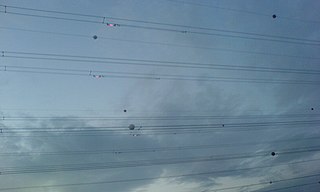 W
WBalisor is a system of illuminated beacons for high voltage power lines using a cold-cathode low-pressure neon lamp, used as an aircraft warning light.
 W
WA beach advisory is a warning given by a local government to avoid swimming in a body of water. Beach advisories do not automatically close bodies of water to swimmers but instead function as a warning to swimmers against swimmining at a particular site.
 W
WThe Broadmoor Sirens are a series of thirteen warning sirens based in towns and villages surrounding Broadmoor Hospital in Crowthorne, Berkshire, England. They were first installed in 1952 and are based on air raid sirens with the intention of warning residents living near the high-security psychiatric hospital of an escaped patient.
 W
WIn the 9th century, during the Arab–Byzantine wars, the Byzantine Empire used a system of beacons to transmit messages from the border with the Abbasid Caliphate across Asia Minor to the Byzantine capital, Constantinople.
 W
WCarWings, renamed NissanConnect in 2015, and also branded as Infiniti InTouch is a vehicle telematics service offered by the Nissan Motor Company to drivers in Japan, the United States, Canada, Great Britain, and most other countries where the LEAF is sold. It provides mobile connectivity for on-demand traffic information services and internet provided maps displayed inside select Nissan vehicles. The service began in December 1997, having been installed in the 1997 Nissan Cedric, Nissan Gloria, Nissan President, Nissan Cima and the Nissan Elgrand.
 W
WThe Chrysler Air Raid Siren, or known as the Chrysler Bell Victory Siren is an outdoor warning siren produced during the Cold War era that has an output of 138 dB(C) at 100 feet (30 m).
 W
WClosed-circuit television (CCTV), also known as video surveillance, is the use of video cameras to transmit a signal to a specific place, on a limited set of monitors. It differs from broadcast television in that the signal is not openly transmitted, though it may employ point-to-point (P2P), point-to-multipoint (P2MP), or mesh wired or wireless links. Though almost all video cameras fit this definition, the term is most often applied to those used for surveillance in areas that require additional security or ongoing monitoring. Though videotelephony is seldom called "CCTV" one exception is the use of video in distance education, where it is an important tool.
 W
WCOBRA COunter Battery RAdar is a Counter-battery radar system developed jointly by Thales, Airbus Defence and Space and Lockheed Martin for the German Armed Forces, the French Army and the British Army. It is a mobile Active electronically scanned array 3D radar based on a wheeled chassis for the purpose of enemy field artillery acquisition.
 W
WCONELRAD was a method of emergency broadcasting to the public of the United States in the event of enemy attack during the Cold War. It was intended to allow continuous broadcast of civil defense information to the public using radio stations, while rapidly switching the transmitter stations to make the broadcasts unsuitable for Soviet bombers that might attempt to home in on the signals.
 W
WA counter-battery radar is a radar system that detects artillery projectiles fired by one or more guns, howitzers, mortars or rocket launchers and, from their trajectories, locates the position on the ground of the weapon that fired it. Such radars are a subclass of the wider class of target acquisition radars.
 W
WThe domestic canary, often simply known as the canary, is a domesticated form of the wild canary, a small songbird in the finch family originating from the Macaronesian Islands.
 W
WElectric vehicle warning sounds are sounds designed to alert pedestrians to the presence of electric drive vehicles such as hybrid electric vehicles (HEVs), plug-in hybrid electric vehicles (PHEVs), and all-electric vehicles (EVs) travelling at low speeds. Warning sound devices were deemed necessary by some government regulators because vehicles operating in all-electric mode produce less noise than traditional combustion engine vehicles and can make it more difficult for pedestrians and cyclists to be aware of their presence. Warning sounds may be driver triggered or automatic at low speeds; in type, they vary from clearly artificial to those that mimic engine sounds and those of tires moving over gravel.
 W
WFLARM is an electronic system used to selectively alert pilots to potential collisions between aircraft. It is not formally an implementation of ADS-B, as it is optimized for the specific needs of light aircraft, not for long-range communication or ATC interaction. FLARM is a portmanteau of "flight" and "alarm". The installation of all FLARM devices is approved as a European Aviation Safety Agency Standard Change, and PowerFLARM Core specifically has been approved as a Minor Change by EASA. In addition to the Standard Change, the Minor Change approves PowerFLARM Core to be used during IFR and at night.
 W
WG-Book is a telematics subscription service provided by Toyota Motor Corporation in Japan for its Toyota- and Lexus-branded vehicles. G-Book allows users to link with cellphones. personal digital assistants (PDA)'s, personal computers (PC) and G-Book equipped cars across Japan. It is based on the former GAZOO infrastructure of Toyota's membership-based information service and membership system, and it provides interactive information services via vehicle installed touch-screen wireless communication terminals. It also incorporates information from Toyota Mapmaster Inc. which updates digital mapping information and is used by various international companies.
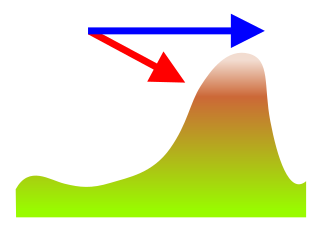 W
WA Ground Proximity Warning System (GPWS) is a system designed to alert pilots if their aircraft is in immediate danger of flying into the ground or an obstacle. The United States Federal Aviation Administration (FAA) defines GPWS as a type of terrain awareness warning system (TAWS). More advanced systems, introduced in 1996, are known as enhanced ground proximity warning systems (EGPWS), a modern type of TAWS.
 W
WHazchem is a warning plate system used in Australia, Malaysia, New Zealand, India and the United Kingdom for vehicles transporting hazardous substances, and on storage facilities. The top-left section of the plate gives the Emergency Action Code (EAC) telling the fire brigade what actions to take if there's an accident or fire. The middle-left section containing a 4 digit number gives the UN Substance Identification Number describing the material. The lower-left section gives the telephone number that should be called if special advice is needed. The warning symbol in the top right indicates the general hazard class of the material. The bottom-right of the plate carries a company logo or name.
 W
WPlacing a severed head on a spike is a custom used sometimes in human history and in culture. The symbolic value may change over time. It may give a warning to spectators. The head may be a human head or an animal head.
 W
WInternavi is a vehicle telematics service offered by the Honda Motor Company to drivers in Japan. In the United States, the service is known as HondaLink, or sometimes MyLink. It provides mobile connectivity for on-demand traffic information services and internet provided maps displayed inside selected Honda vehicles. The service began August 1997 and was first offered in the 1998 Honda Accord and the Honda Torneo sold only in Japan starting July 1998. The service received a revision to services offered October 2002, adding traffic information delivery capabilities for subscribers to the Internavi Premium Club, and was optional on most Honda vehicles sold in Japan. VICS was integrated into the service starting September 2003. Membership in the service has steadily grown to exceed 5 million subscribers as of March 2007.
 W
WIn road-transport terminology, lane centering, also known as auto steer, is a mechanism designed to keep a car centered in the lane, relieving the driver of the task of steering. Lane centering is similar to lane departure warning, but rather than warn the driver, or bouncing the car away from the lane edge, it keeps the car centered in the lane. Together with adaptive cruise control (ACC), this feature may allow unassisted driving for some length of time.
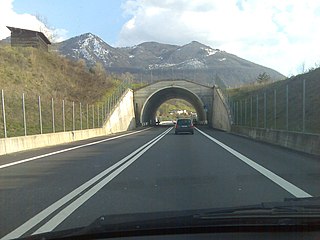 W
WIn road-transport terminology, a lane departure warning system (LDWS) is a mechanism designed to warn the driver when the vehicle begins to move out of its lane on freeways and arterial roads. These systems are designed to minimize accidents by addressing the main causes of collisions: driver error, distractions and drowsiness. In 2009 the U.S. National Highway Traffic Safety Administration (NHTSA) began studying whether to mandate lane departure warning systems and frontal collision warning systems on automobiles.
 W
WA law enforcement warning is a warning issued through the Emergency Alert System (EAS) in the United States to warn the public of criminal events that pose a threat to public safety. These include jailbreaks, riots, and bomb explosions. An authorized law enforcement agency may blockade roads, waterways, or facilities, evacuate or deny access to affected areas, and arrest violators or suspicious persons. The warning is usually issued by a law enforcement agency and is relayed by the National Weather Service.
 W
WMobileye is an Israeli subsidiary of Intel corporation that develops vision-based self-driving car and advanced driver-assistance systems (ADAS) providing warnings for collision prevention and mitigation. Mobileye headquarters and main R&D centre is located in Jerusalem operating under the company name Mobileye Vision Technology Ltd. The company also has sales and marketing offices in Midtown, Manhattan, US; Shanghai, China; Tokyo, Japan and Düsseldorf, Germany.
 W
WThe National Emergency Alarm Repeater (NEAR) was a civilian emergency warning device in the United States. It was a 2–3" (5–7.5 cm) square box designed to plug into a standard power outlet to receive a special signal sent over the electric power transmission lines. Research and testing for the NEAR program was developed in 1956 during the Cold War to supplement the existing siren warning systems and radio broadcasts in the event of a nuclear attack. The advent of the radio Emergency Broadcast System rendered NEAR obsolete, although a severe disadvantage inherent in the Emergency Broadcast System was that it required a television or radio to be turned on for a household to receive the emergency alarm, whereas NEAR did not. Despite this advantage, upon the introduction of the Emergency Broadcast System, stockpiled NEAR repeaters were destroyed by their respective manufacturers.
 W
WThe National Tsunami Warning Center (NTWC) forms part of an international tsunami warning system (TWS). It serves as the operations center for all coastal regions of Canada and the United States, except Hawaii, the Caribbean, and the Gulf of Mexico. Headquartered in Palmer, Alaska, it is operated by the National Oceanic and Atmospheric Administration (NOAA).
 W
WThe Pacific Tsunami Warning Center (PTWC) is one of two tsunami warning centers that are operated by NOAA in the United States. Headquartered on Ford Island, HI, the PTWC is part of an international tsunami warning system (TWS) program and serves as the operational center for TWS of the Pacific issuing bulletins and warnings to participating members and other nations in the Pacific Ocean area of responsibility. It is also the regional (local) warning center for the State of Hawaii. The other tsunami warning center is the National Tsunami Warning Center (NTWC) in Palmer, Alaska, serving all coastal regions of Canada and the United States except Hawaii, the Caribbean Sea and the Gulf of Mexico.
 W
WPhysical security describes security measures that are designed to deny unauthorized access to facilities, equipment and resources and to protect personnel and property from damage or harm. Physical security involves the use of multiple layers of interdependent systems that can include CCTV surveillance, security guards, protective barriers, locks, access control, perimeter intrusion detection, deterrent systems, fire protection, and other systems designed to protect persons and property.
 W
WRadar warning receiver (RWR) systems detect the radio emissions of radar systems. Their primary purpose is to issue a warning when a radar signal that might be a threat is detected. The warning can then be used, manually or automatically, to evade the detected threat. RWR systems can be installed in all kind of airborne, sea-based, and ground-based assets. This article is focused mainly on airborne military RWR systems; for commercial police RWR systems, see radar detector.
 W
WDenge is a former Royal Air Force site near Dungeness, in Kent, England. It is best known for the early experimental acoustic mirrors which remain there.
 W
WThe Red Color is an early-warning radar system installed by the Israel Defense Forces in several towns surrounding the Gaza Strip to warn civilians of imminent attack by rockets. Outside of areas serviced by the Red Color system, standard air raid sirens are used to warn of rocket attacks.
 W
WRemove before flight is a safety warning often seen on removable aircraft and spacecraft components, typically in the form of a red ribbon, to indicate that a device, such as a protective cover or a pin to prevent the movement of mechanical parts, is only used when the aircraft is on the ground. On small general aviation aircraft, this may include a pitot tube cover or a control lock. The warning appears in English only. Other ribbons labelled "pull to arm" or similar are found on missiles and other weapon systems that are not mounted on aircraft.
 W
WSafety signs are a type of sign designed to warn of hazards, indicate mandatory actions or required use of Personal protective equipment, prohibit actions or objects, identify the location of firefighting or safety equipment, or marking of exit routes.
 W
WThe Severnside Sirens are a system of Civil defense sirens located along the South Severn Estuary coastline from Redcliffe Bay to Pilning, northwest of Bristol. They are activated by Avon and Somerset Police in the event of a potential incident at one of the COMAH sites located in the area, mainly in and near Avonmouth. The system was setup in 1997 following a fire at the Albright and Wilson site in 1996.
 W
WA warning sign is a type of sign which indicates a potential hazard, obstacle, or condition requiring special attention. Some are traffic signs that indicate hazards on roads that may not be readily apparent to a driver.
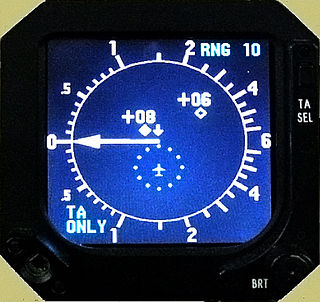 W
WA traffic collision avoidance system or traffic alert and collision avoidance system is an aircraft collision avoidance system designed to reduce the incidence of mid-air collisions between aircraft. It monitors the airspace around an aircraft for other aircraft equipped with a corresponding active transponder, independent of air traffic control, and warns pilots of the presence of other transponder-equipped aircraft which may present a threat of mid-air collision (MAC). It is a type of airborne collision avoidance system mandated by the International Civil Aviation Organization to be fitted to all aircraft with a maximum take-off mass (MTOM) of over 5,700 kg (12,600 lb) or authorized to carry more than 19 passengers. CFR 14, Ch I, part 135 requires that TCAS I be installed for aircraft with 10-30 passengers and TCAS II for aircraft with more than 30 passengers.
 W
WA tripwire is a passive triggering mechanism. Typically, a wire or cord is attached to some device for detecting or reacting to physical movement.
 W
WA tsunami warning system (TWS) is used to detect tsunamis in advance and issue the warnings to prevent loss of life and damage to property. It is made up of two equally important components: a network of sensors to detect tsunamis and a communications infrastructure to issue timely alarms to permit evacuation of the coastal areas. There are two distinct types of tsunami warning systems: international and regional. When operating, seismic alerts are used to instigate the watches and warnings; then, data from observed sea level height are used to verify the existence of a tsunami. Other systems have been proposed to augment the warning procedures; for example, it has been suggested that the duration and frequency content of t-wave energy is indicative of an earthquake's tsunami potential.
 W
WIn October 2006, the United States Geological Survey (USGS) adopted a nationwide alert system for characterizing the level of unrest and eruptive activity at volcanoes. The system is now used by the Alaska Volcano Observatory, the California Volcano Observatory, the Cascades Volcano Observatory, the Hawaiian Volcano Observatory and the Yellowstone Volcano Observatory.
 W
WZoopark-1 1L219 is a Counter-battery radar system developed jointly by Almaz-Antey for the Russian Armed Forces. It is a mobile Passive electronically scanned array radar based on a tracked MT-LBu chassis for the purpose of enemy field artillery acquisition. The system can detect moving ground targets at a distance of up to 40 kilometers.